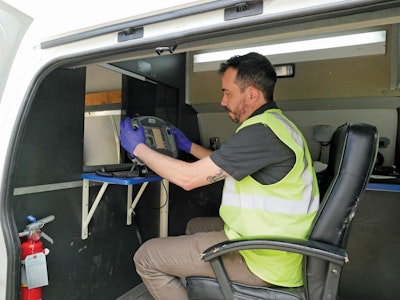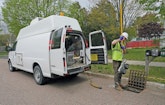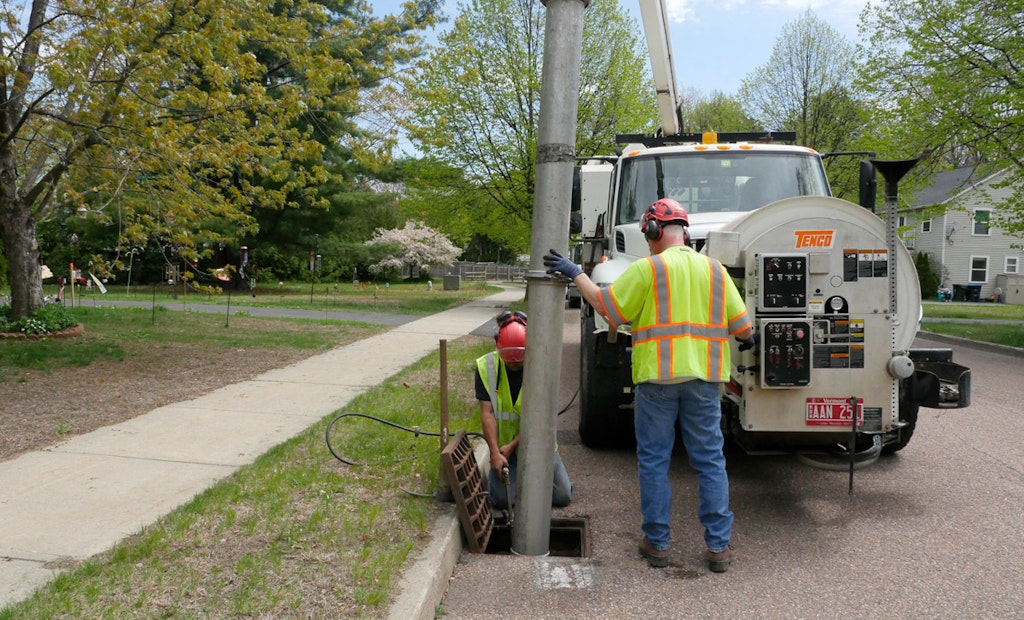Interested in Stormwater?
Get Stormwater articles, news and videos right in your inbox! Sign up now.
Stormwater + Get AlertsIf you’re with a New England utility and looking for some stormwater management guidance, the City of South Burlington, Vermont, is a logical place to start. In fact, as the first municipality in the state to establish a stormwater utility in 2005, South Burlington has done just that for many communities over the years.
“We’ve seen a bunch of other stormwater utilities pop up in Vermont, and in the New England area in general,” says Dave Wheeler, South Burlington Stormwater Services superintendent. “These communities are looking to others to see what has worked. So being the first stormwater utility in Vermont, we have definitely done a lot of presentations, usually at conferences, on starting up a utility and what goes into it.”
The core function of such a utility is of course to fund stormwater management projects. Since 2005, South Burlington has been plenty busy in that regard and has made a lot of progress in how stormwater is impacting the area’s watersheds. But, Wheeler notes, there is still a lot of work left to do. With some extra funding for stormwater projects coming from the American Rescue Plan Act passed in early 2021, the future promises to be busy.
“It’s an exciting time here. Hopefully we have enough engineers and contractors to do all the work,” Wheeler says.
Confronting the problem
South Burlington serves a population of 18,000 and its stormwater infrastructure consists of 180 miles of conveyance and 6,700 drainage structures. Of that, the city owns and maintains 100 miles of conveyance and 3,400 drainage structures. The rest is the responsibility of private property owners. South Burlington Stormwater Services has a four-person maintenance crew that handles a variety of tasks, including catch basin cleaning, street sweeping, outfall inspections and stormwater treatment practice inspections and maintenance.
The need for changes in how stormwater was being managed in the area started to reveal itself in the early 2000s. In 2000, the EPA authorized Vermont’s Agency of Natural Resources to implement Phase 2 MS4 permits in the state through the Department of Environmental Conservation. Additionally, in Vermont, the state government requires a stormwater permit for any development that produces an acre of impervious surface. For many years, permit requirements were fairly minimal.
“In the 1980s and earlier, it was basically put in catch basins and storm drains and discharge to the stream,” Wheeler says. “They had requirements for cleaning the catch basins and sweeping parking lots thinking that was sufficient, but there were no requirements for stormwater treatment.”
That started to change in the late 1980s with the rollout of the state’s stormwater management procedures, which included requirements like flood control for a 10-year storm. In 1997, the procedures were updated with additional requirements to address stormwater treatment. Then in 2002, the state rolled out the first edition of its stormwater management manual, which included design requirements for stormwater treatment practices, addressing five categories: water quality, channel protection, groundwater recharge, moderate flooding events and extreme flooding events. At that time, South Burlington had 141 stormwater permits (many of them expired) as well as five watersheds the state deemed stormwater-impaired.
“The state sends biologists out to look for fish and insects, and if they don’t find what they are looking for, the stream is deemed impaired,” Wheeler says. “The state had to determine what was causing the impairment, and in many of our streams in Vermont, they decided it was stormwater in general, realizing that it is kind of an umbrella term including stream bank erosion from increased velocity, turbidity, thermal modifications, nutrients loading, along with other pollutants like metals, fertilizers and hydrocarbons.”
The objective then was to mitigate that negative impact by reducing peak stormwater flows and installing treatment practices.
“There was an issue where people with expired stormwater permits couldn’t renew their permit in an impaired watershed, unless they had stormwater treatment systems that meet the requirements of the stormwater management manual. So that was a huge driver for the creation of the stormwater utility,” Wheeler says. “One of the goals was to be able to provide neighborhoods with maintenance of the treatment systems they were going to need to build or upgrade. Additionally, the city had its MS4 permit to comply with.”
Getting support
Although South Burlington was Vermont’s first stormwater utility, officials did have plenty of examples from other states to use as an initial template. They eventually settled on the equivalent residential unit (ERU) model, where an average baseline is established and every residential property owner gets billed one ERU no matter their amount of impervious surface. A tiered structure is then set up for commercial properties that is based off of square footage.
As it is with the establishment of anything new, public outreach was imperative.
“There were a lot of meetings and plenty of discussion. People are always going to have a certain amount of pushback at the beginning of something new,” Wheeler says. “That’s why it’s important to reach out to people and explain to them the ‘why’ — that correlation between impervious surface and generating stormwater. Then you still need to handle the calls you get as you roll out the first stormwater bills. Residents will say things like, ‘Well, my house doesn’t generate runoff,’ or ‘My runoff just flows into a wetland behind the house and disappears.’ You just have to keep explaining. Make those connections for people.”
Overall, South Burlington residents accepted the stormwater utility quickly. In addition to the public outreach, another factor that helped, Wheeler says, is South Burlington’s prominent location on the shores of Lake Champlain.
“Being next to the lake was a big motivation for South Burlington to act,” Wheeler says. “The residents truly care about the lake. It provides great recreational opportunities, it’s the source of our drinking water, and there are stunning sunset views of the lake and the Adirondacks from where we are located. I think the fact that residents can see the lake from parts of the city kind of drives the point home about stormwater.”
Peak flows and phosphorus
Since establishing the stormwater utility, South Burlington Stormwater Services has been busy with projects. To date, utility fees have produced $25 million, which has been leveraged to obtain another $5 million from state and federal grants. Some of those funds have gone toward tackling a list of 150 different projects that are part of flow restoration plans for each stormwater-impaired watershed, aimed at knocking down peak flows for one-year storm events (2 inches of rain in a 24-hour period). The deadline on those projects is 2032.
“We have a prioritization ranking,” Wheeler says. “We started with projects that were the low-hanging fruit. It made sense to get projects that were the most cost-effective and would have the greatest water quality benefit in the ground first.”
Phosphorus control is also a significant component of the various projects as South Burlington has a phosphorus TMDL to Lake Champlain it must comply with. Wheeler cites one project from recent years as an example of the type of work that South Burlington has been targeting in order to achieve the desired results.
The local airport had received money from the FAA to conduct a home buyout program, which has removed about 145 homes from the area surrounding the airport in order to address noise issues from the planes. On Picard Circle, all of the existing houses were removed. So the city was left with a short road and cul de sac with no homes to serve.
“It was right next to a stream. And there was a large drainage area discharging to the stream untreated,” Wheeler says. “We routed the drainage into the cul de sac area. We removed the road and utilities and put in a large underground chamber system to infiltrate the runoff.”
The project reduced peak flows from a one-year storm event by 87%. On top of that, it reduced the amount of phosphorus going to Lake Champlain by 33 kg per year, 25% of South Burlington’s required reduction.
“That provided us with a huge credit in our phosphorus TMDL for Lake Champlain,” Wheeler says. “We just submitted our draft phosphorus control plan to the state, which showed we were exceeding our required phosphorus reduction by 32%.”
Collaboration is key
For municipalities looking to improve their stormwater management game, Wheeler suggests first taking a look at what neighboring communities are doing.
“I think trying to be consistent on a regional basis is important,” he says. “It can allow residents to better understand what their utility bill is all about or allow engineers to better understand what the local stormwater design requirements are.”
South Burlington officials coordinate with those from surrounding communities on the public outreach front. In 2003, the MS4 communities in the region formed the Regional Stormwater Education Program to meet the public outreach requirements of the MS4 permit. In 2011, they formed a group called the Chittenden County Stream Team to meet the public participation requirements of the permit. In 2017, the two groups merged and rebranded under the Rethink Runoff program, which runs the website www.rethinkrunoff.org.
“It allows us to put out consistent messaging through digital advertising and radio ads,” Wheeler says. “That way people aren’t hearing one message from Burlington, a different message from South Burlington, etc. There’s both a cost savings and a unified message, which has been good.”
The success of the outreach efforts has been proven through periodic surveys.
“The survey is set up almost like a test. We ask residents general questions about runoff and other stormwater concepts,” Wheeler says. “In the beginning, people didn’t have the greatest technical understanding of the issues, but as time went on and we continued our messaging, there was a definite improvement in general awareness and understanding. In the most recent survey we conducted around behavior, we found that 83% of respondents report that they pick up pet waste compared to 62% in 2013. Additionally, only 21% use fertilizers on their lawn, which is down from 50% in 2013.”
Beyond the shared public outreach efforts, South Burlington also frequently communicates with its neighboring communities so that all the stormwater programs are aware of what kind of work is happening in the larger region.
“These watersheds cross town boundaries, so when we develop flow restoration plans, we have to work together,” Wheeler says. “Collaboration is very important.”
A busy future
South Burlington Stormwater Services will be extremely active in the coming years. As much as has been accomplished in the past 15 years, aided by the stormwater utility, a significant amount of work lies ahead. For a lot of it, South Burlington will be helping private property owners with their stormwater management responsibilities. Wheeler says that until late last year the state legislature had essentially been allowing property owners with expired stormwater permits to defer. But now those permit holders are finally on a deadline to do the necessary stormwater upgrades.
“We’ve known this was coming for the past 15 years, so we’ve been working proactively with neighborhoods to upgrade their systems,” Wheeler says.
There is also now a state mandate requiring stormwater treatment for any property with 3 acres or more of impervious surface, even if that property wasn’t previously required to obtain a stormwater permit. They’re no longer grandfathered in.
“That was an unfunded mandate by the legislature, and it looks like the state is now going to direct money from American Rescue Plan Act funds to help that effort,” Wheeler says. “It could be a busy couple of years because that money has to be spent by 2024.”
The amount of work left to do is seemingly endless, but South Burlington has also made considerable progress in managing its stormwater since first deciding to confront the issue.
“We’re definitely in a much better place now than 15 years ago,” Wheeler says. “The public awareness is there. I would say our community is very knowledgeable about stormwater just based on various interactions I’ve had with residents. We’ve installed a lot of stormwater treatment practices. It’s hard because people see the money being spent, and they want to see the lake clean with no more algae blooms. That’s going to take more time, but what we’ve done so far is pretty significant.”








